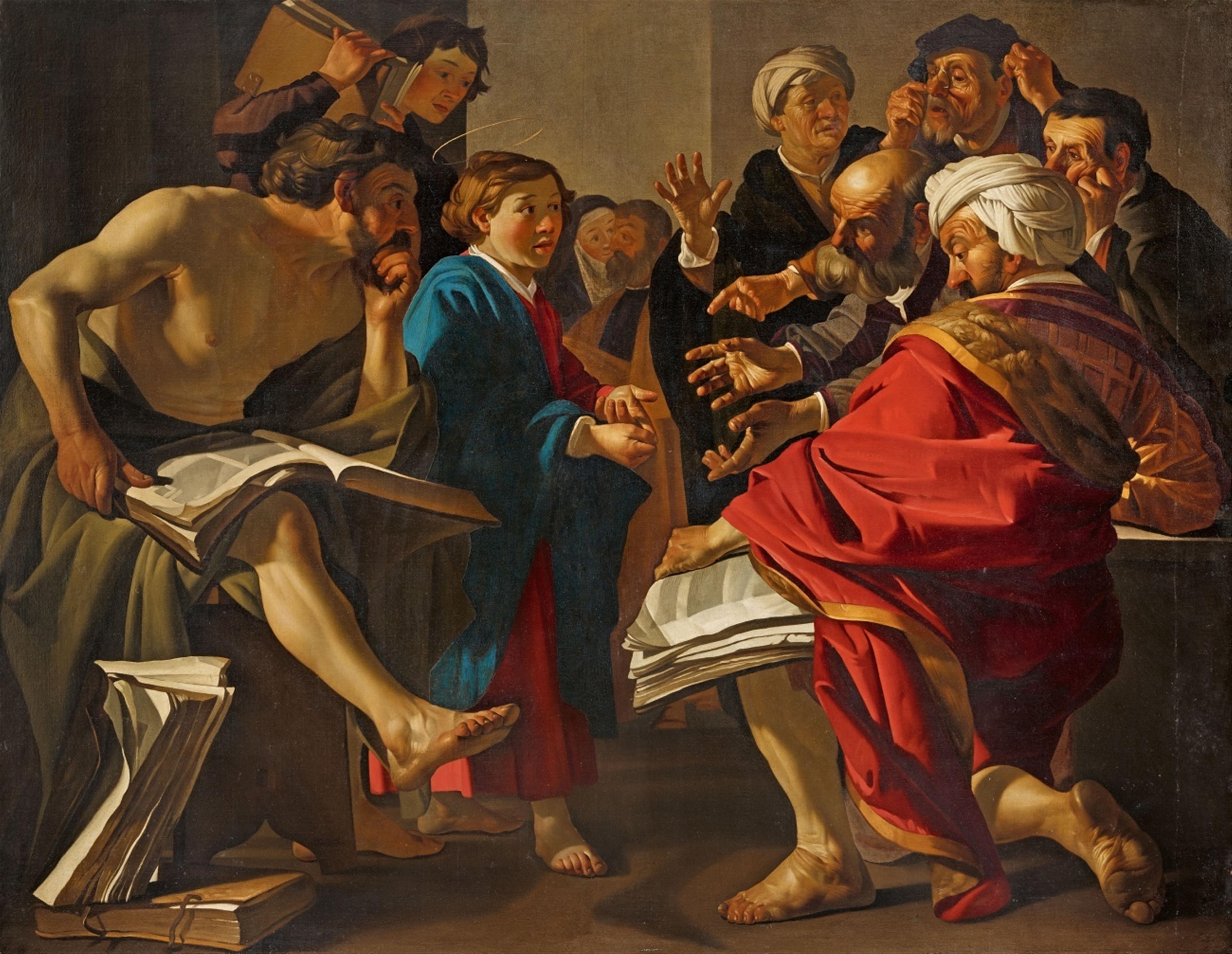Dirck van Baburen
Christ among the Doctors
Oil on canvas (relined). 165.7 x 215.9 cm.
This painting depicts Dirck van Bauburen's high quality replica of a composition, the first version of which is found in the Nasjonal Galleriet in Oslo (Franits 2013, p. 122-123). It was created in 1622 shortly after the artist's return from Rome to Utrecht. This ambitious composition demonstrates all the skills van Baburen acquired in the High Baroque era of Rome and with it competes wth the leading artists of his homeland in the field of historical painting. While Leonard Slatkes was unable to see the painting in its original when compiling his catalogue raisonné (Slatkes 1962, op. cit.; Slatkes 1965, op. cit.), Wayne Franits emphasized the quality of the painting and even dedicated a colour plate to this version, not the one in Oslo, in the catalogue raisonné. According to concurring information in older art historical literature, the painting was once signed and dated.
The event from Jesus' childhood was portrayed in the New Testament (Luke II, 41-52): as Joseph and Maria returned from visiting the temple and realized the twelve-year-old Jesus was missing, they turned back. They found him in the temple debating with the doctors who were amazed by the child's wisdom. Van Baburen presents the scene in an dynamic composition with the contrast between the debating twelve-year-old Jesus and the astonished, wildly gesticulating doctors. The boyish Jesus stands in the centre of the picture in calm, firm contrapposto. His hands form the gesture of enumerating arguments - one used to express reasonable speech since ancient rhetoric. In contrast, the facial expressions and gestures of the doctors show their incredulous astonishment. How cleverly van Baburen conceived the picture is shown by Jesus' debating hands forming the exact centre of the picture and carrying the message of the picture in nuce.
The theme of the twelve-year-old Jesus in the temple was handled not by Caravaggio himself, but many times in the circle of the Caravaggesques such as Bartolomeo Manfredi and Jusepe de Ribera. In 1615, while still in Rome, van Baburen himself expressed how widespread this theme was in the circle of Caravaggesques, with a half-figural composition (cf. fig. 1). Only after his return to Utrecht did he conceive the present depiction, an ambitious full-figural history picture, obviously rivaling similar history pictures by Hendrick ter Brugghen. The powerful chiaroscuro, the monumental conception of the figures or the moving representation of the emotions - Dirck van Braburen was able to study these elements, which distinguish this painting, in the works of Caravaggio and the Caravaggesques in Rome. He saw them for example in the palace of Vincenzo Giustiniani, a prominent patron of Caravaggio, where van Baburen lived whilst in the city. Art connoisseurs, as well as art colleagues in Utrecht should see that he had mastered the modern visual language of the Roman Baroque. It is probably no coincidence therefore that one sees the dirty sole of the doctor's feet to the right of the painting, a motif from Caravaggio's Madonna dei Pellegrini in the church of Sant'Agostino, which has always electrified admirers of Caravaggio's art.
However, van Braburen does not only refer to Caravaggio's works in this picture. He was able to study how an emotionally astonished group of figures are arranged around a calm, central figure in a central work of the Roman High Renaissance, namely Raphael's altar picture of the Transfiguration (Vatican Museum). Van Baburen had ample opportunity to study this work, as at that time it was in San Pietro in Montorio, the church for which the artist carried out his most important commission of his Roman period.
The composition was obviously a great success. The numerous copies, but above all the many works by other artists who took up the composition, bear witness to this. Included in this is a painting by Mathias Stormer, created about ten years later (Fig. 2). It adopted the entire composition, but also single pictorial elements such as the figure of the doctor to the right, whose cloak Stomer also painted in a powerful red - the bright red that Wayne Franits has described in this painting as „rich vermilion robe of the doctor, which is truly magnificent“.

